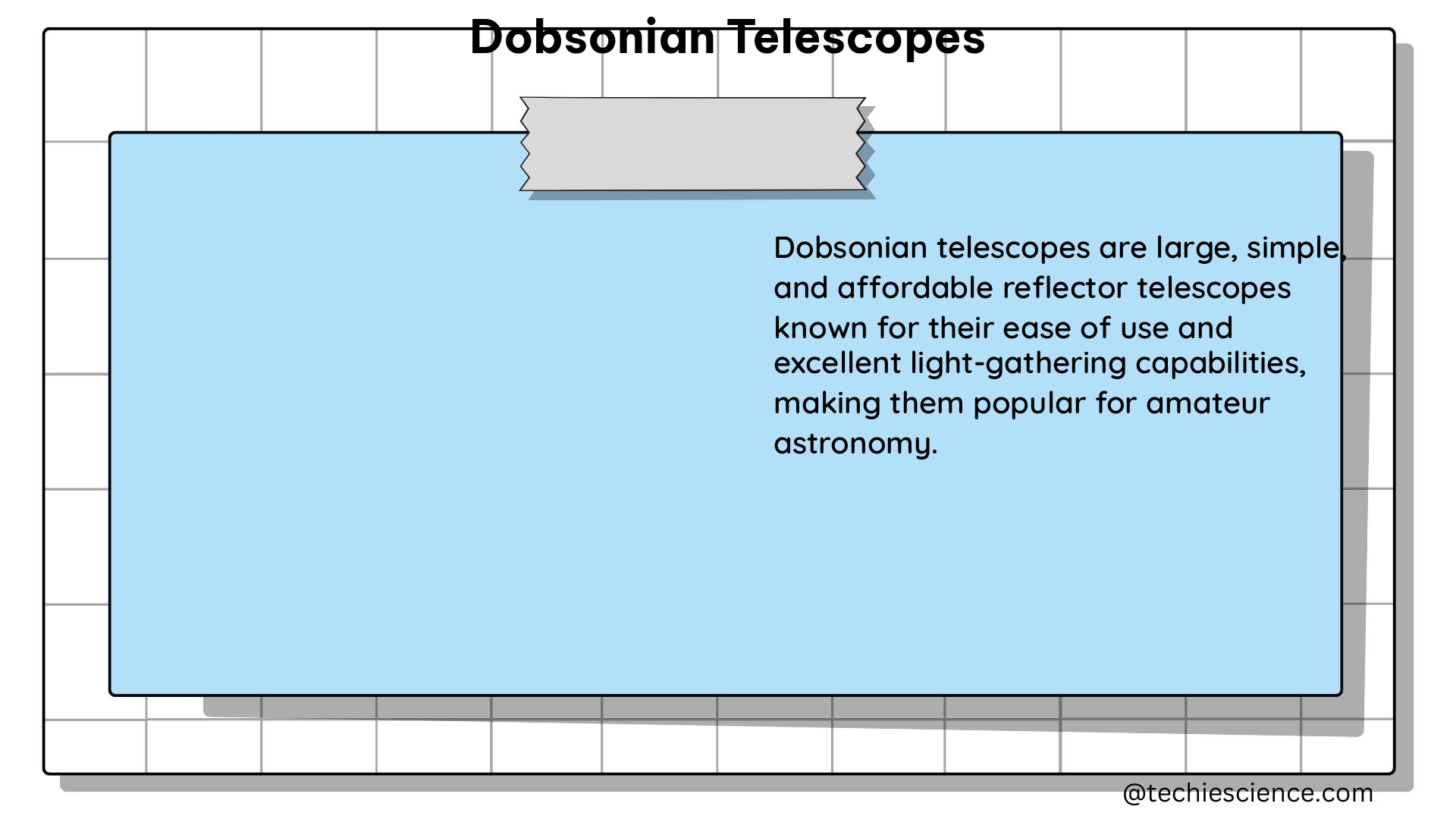Dobsonian telescopes are a popular choice among amateur astronomers due to their simplicity, affordability, and large aperture. These reflector telescopes utilize a parabolic primary mirror to collect and focus light, providing a wide field of view and exceptional light-gathering capabilities that make them ideal for observing deep-sky objects like galaxies, nebulae, and star clusters.
Understanding Dobsonian Telescope Specifications
Aperture: The Key to Light Gathering
The aperture, or the diameter of the primary mirror, is a crucial specification of a Dobsonian telescope. A larger aperture allows for more light to be collected, resulting in brighter and more detailed images. For example, a 10-inch Dobsonian telescope with a 254mm aperture can collect 635 times more light than the naked eye, enabling the observation of fainter objects and revealing more intricate details in bright celestial bodies.
The relationship between aperture and light-gathering power can be expressed mathematically as:
Light-gathering power = (Aperture diameter)^2
This means that doubling the aperture diameter will result in a four-fold increase in the telescope’s light-gathering capability.
Focal Length and Magnification
Another important specification is the focal length, which is the distance between the primary mirror and the focus point. The focal length determines the magnification power of the telescope, with longer focal lengths providing higher magnification and a narrower field of view.
The magnification of a Dobsonian telescope can be calculated using the formula:
Magnification = Focal length of telescope / Focal length of eyepiece
For example, a Dobsonian telescope with a focal length of 1200mm and a 25mm eyepiece will have a magnification power of 48x.
The Alt-Azimuth Mount: Smooth and Easy Operation
Dobsonian telescopes are typically mounted on a simple alt-azimuth mount, which allows for smooth and easy movement in both altitude (up and down) and azimuth (left and right) directions. This mount is designed for manual operation, making it accessible even for beginner astronomers.
The alt-azimuth mount works on the principle of two perpendicular axes of rotation, one for altitude and one for azimuth. This design allows the telescope to be pointed at any object in the sky by adjusting these two axes independently.
The Physics of Dobsonian Telescopes

Dobsonian telescopes operate on the principles of reflection and refraction, which are fundamental concepts in optics.
Reflection and the Parabolic Mirror
The primary mirror of a Dobsonian telescope is typically a parabolic mirror, which is designed to reflect light parallel to the optical axis to a single focus point. This design allows for a wide field of view and high light-gathering capability.
The reflection of light by the parabolic mirror can be described by the following equation:
sin(θi) = sin(θr)
Where θi is the angle of incidence and θr is the angle of reflection. This relationship, known as the law of reflection, ensures that the light is reflected in a way that converges at the focal point.
Refraction and the Eyepiece
The eyepiece of a Dobsonian telescope is responsible for magnifying the image formed by the primary mirror. This process involves the refraction of light as it passes through the lens of the eyepiece.
The relationship between the focal length of the eyepiece and the magnification can be expressed using the following formula:
Magnification = Focal length of telescope / Focal length of eyepiece
The refractive index of the lens material, as well as the curvature of the lens surfaces, determines the degree of refraction and, consequently, the magnification.
Improving the Viewing Experience
To enhance the views through a Dobsonian telescope, several factors can be considered:
Eyepiece Selection
Using a higher magnification eyepiece can provide more detail, but it also narrows the field of view. Choosing the appropriate eyepiece for the observing task is crucial to balance magnification and field of view.
Reducing Light Pollution
Light pollution can significantly degrade the contrast and visibility of faint celestial objects. Observing from a location with minimal light pollution can greatly improve the viewing experience.
Dark Adaptation
Allowing the eyes to adapt to low light conditions for at least 30 minutes can enhance the observer’s ability to perceive faint details and objects.
Conclusion
Dobsonian telescopes are a versatile and accessible choice for amateur astronomers, offering a combination of large aperture, wide field of view, and easy-to-use operation. By understanding the key specifications, the underlying physics principles, and the factors that can improve the viewing experience, physics students can fully harness the power of these remarkable instruments and embark on a captivating journey of celestial exploration.
References:
- Hinged Shelter for Dobsonian Telescopes – Observatories
- Expectations vs reality of a dobsonian telescope – Reddit
- Making and Testing a Telescope Mirror Homemade 12.5 Inch Dobsonian Telescope – Instructables
- Dobsonian Telescope Basics – Sky & Telescope
- The Dobsonian Telescope – Astronomy magazine
- Dobsonian Telescope Design – University of Arizona
- How Dobsonian Telescopes Work – HowStuffWorks
- Dobsonian Telescope Optics – Explain that Stuff
- Dobsonian Telescope Mounts – Telescope Basics

The lambdageeks.com Core SME Team is a group of experienced subject matter experts from diverse scientific and technical fields including Physics, Chemistry, Technology,Electronics & Electrical Engineering, Automotive, Mechanical Engineering. Our team collaborates to create high-quality, well-researched articles on a wide range of science and technology topics for the lambdageeks.com website.
All Our Senior SME are having more than 7 Years of experience in the respective fields . They are either Working Industry Professionals or assocaited With different Universities. Refer Our Authors Page to get to know About our Core SMEs.